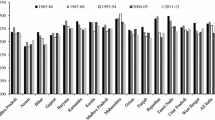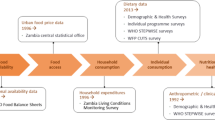Abstract
In the United States food has become a weapon for social control. Hunger and conversely obesity have contributed to the subjugation of underserved populations and served to perpetuate social inequality. This research provides an analysis of the literature on factors that influence obesity rates, however the question of why these factors play a significant role probes deeper into the political and social structures that lend themselves to such inequities. Obesity rates have historically been higher in Southern states, leading to a consideration of historical food preparation and consumption practices and the intergenerational transmission of food culture. This study uses ordinary least squares regression and data from the Centers for Disease Control, and Prevention (CDC), the United State Department of Agriculture (USDA) and the U.S. Census to examine the factors that influence state level obesity rates. The results indicate a significant positive correlation between Supplemental Nutritional Assistance Program (SNAP) assistance and the obesity rate. Lack of physical activity and the percentage of African American residents are also significantly correlated with the level of obesity. In contrast healthy food outlets within a half-mile of the residence appear to be associated with lower levels of obesity.
Similar content being viewed by others
Notes
Body Mass Index (BMI) is a number calculated from a person’s weight and height. It provides a reliable indicator of body fatness for most people and is used to screen for weight categories that may lead to health problems.
SNAP State Activity Report, Fiscal Year 2011
U.S. Bureau of the Census, Population Estimates Program (PEP), Race
References
Baum CL. The effects of food stamps on obesity. South Econ J. 2011;77(3):623–51.
Bentley TG, Palta M, Paulsen AJ, Cherepanov D, Dunham NC, Feeny D, et al. Race and gender associations between obesity and nine health-related quality-of-life measures. Qual Life Res. 2011;20(5):665–74.
CDC. “Defining Overweight and Obesity”. 2012. http://www.cdc.gov/obesity/adult/defining.html. Accessed 2 Nov 2013.
Cossrow N, Falkner B. Race/ethnic issues in obesity and obesity-related comorbidities. J Clin Endocrinol Metab. 2004;89(6):2590–4.
Drewnowski A, Aggarwal A, Hurvitz P, Monsivais P, Moudon A. Obesity and supermarket access: proximity or price? Am J Pub Health. 2012;102(8):e74–80.
Drewnowski A, Darmon N. The economics of obesity: dietary energy density and energy cost. Am J Clin Nutr. 2005;82(1):265S–273S.
Dwyer-Lindgren L, Freedman G, Engell RE, Fleming TD, Lim SS, Murray CL, et al. Prevalence of physical activity and obesity in US counties, 2001–2011: a road map for action. Popul Health Metrics. 2013;11(1):7–17.
Ford P, Dzewaltowski D. Disparities in obesity prevalence due to variation in the retail food environment: three testable hypotheses. Nutr Rev. 2008;66(4):216–28.
Grilo CM. Physical activity and obesity. Biomed Pharmacother. 1994;48(3):127–36.
Grimm KA, Moore LV, Scanlon KS. Access to healthier food retailers—United States, 2011. CDC Health Disparities Inequalities Rep—United States. 2013;62(3):20.
Henderson L. “Ebony Jr!” and “soul food”: the construction of middle-class African american identity through the Use of traditional southern foodways. Melus. 2007;32(4):81–97.
Jacobson E, O’Hanlon J, Clark A. Access to healthy foods in the built environment. Health Policy. 2011;3:1–4. A publication of the Institute for Public Administration – University of Delaware.
Jilcott SB, McGuirt JT, Imai S, Evenson KR. Measuring the retail food environment in rural and urban North Carolina counties. J Pub Health Manag Pract. 2010;16(5):432–40. JPHMP.
Philipson T. The world-wide growth in obesity: an economic research agenda. Health Econ. 2001;10(1):1–7.
Rashad I. Assessing the underlying economic causes and consequences of obesity. Gender Issues. 2003;21(3):17–29.
Reidpath D, Burns C, Garrard J, Mahoney M, Townsend M. An ecological study of the relationship between social and environmental determinants of obesity. Health Place. 2002;8(1):141–5.
Ritzer G. The McDonaldization of Society. 6th ed. Thousand Oaks: Pine Forge Press; 2011.
Swinburn BA. Obesity prevention: the role of policies, laws and regulations. Australia and New Zealand health policy. 2008;5(1):12.
Tabak RG, Jones E, Jacobs JA, Dobbs T, Sutton V, Dove C, et al. Policy perceptions related to physical activity and healthy eating in Mississippi. J Publ Health Manag Pract. 2013;19(3 Supplement):S97–S104.
Treuhaft S, Karpyn A. The Grocery Gap: Who Has Access to Healthy Food and Why It Matters. PolicyLink and The Food Trust. (2010).
Author information
Authors and Affiliations
Corresponding author
About this article
Cite this article
Broady, K.E., Meeks, A.G. Obesity and Social Inequality in America. Rev Black Polit Econ 42, 201–209 (2015). https://doi.org/10.1007/s12114-014-9202-1
Published:
Issue Date:
DOI: https://doi.org/10.1007/s12114-014-9202-1




